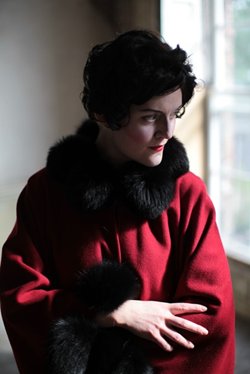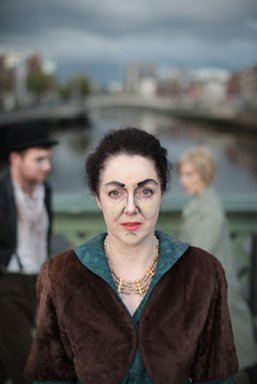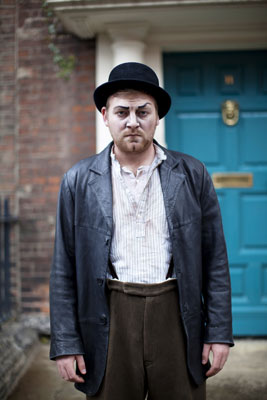‘You’re funny on Twitter,’ Annie Ryan tells me towards the end of our conversation, ‘and you wouldn’t have known.’ Having spied on her actors work up a sweat during high-energy rehearsals at Leinster Cricket Club, Rathmines, moments before we meet, I wonder if I too have just been told to try harder, or maybe not quite so hard. This off-hand serving of compliment and critique might be tougher to take if Ryan hadn’t already made it clear over the course of our chat that she holds her own work with Corn Exchange - the company with which she has been Artistic Director since its founding in 1995 - to incredibly high standards too. It’s not often you’ll find a director who discuses the potential weaknesses of her work as readily as she highlights its merits and ambitions. ‘We’re always improving our work,’ she says, ‘always trying to make it better.’
We meet to discuss the company’s forthcoming theatrical adaption of James Joyce’s Dubliners, the headline show of this year’s Dublin Theatre Festival, and the first production of Joyce’s short story collection to be staged since his work entered the public domain at the beginning of the year. (Some of the stories have been performed in the past, but never to this extent or scale.) If any theatre company were to undertake such an onerous task, it seems fitting that it would be Corn Exchange. In the tradition of Joyce, most of the company’s work throughout the past decade has involved taking a magnifying glass to the lives of the capital city’s people. From Dublin By Lamplight (2004), to Everyday (2006), through to Man of Valour (2011), Corn Exchange has given Irish theatre some of the most moving and memorable studies of ordinary dubliners, animating the longing and heartache that swells and grinds beneath even the most unassuming exteriors.
 In a sense, then, you could say that Corn Exchange has been doing its own version of Dubliners for a long time. Asked about this pattern, playwright Michael West admits ‘it’s a book and a series of stories that’s hovered in the background of our work, but we’ve never really explicitly looked at doing it until quite recently.’ The opportunity to develop the piece came about when Willie White, newly appointed Artistic Director and Chief Executive of Dublin Theatre Festival, approached the company about staging the collection. In the same year as Dublin City Council highlighted Dubliners for its ‘One City, One Book’ initiative, White wanted Dubliners to be the centerpiece of his first festival, which runs with the tagline ‘Your City, Your Stories.’
In a sense, then, you could say that Corn Exchange has been doing its own version of Dubliners for a long time. Asked about this pattern, playwright Michael West admits ‘it’s a book and a series of stories that’s hovered in the background of our work, but we’ve never really explicitly looked at doing it until quite recently.’ The opportunity to develop the piece came about when Willie White, newly appointed Artistic Director and Chief Executive of Dublin Theatre Festival, approached the company about staging the collection. In the same year as Dublin City Council highlighted Dubliners for its ‘One City, One Book’ initiative, White wanted Dubliners to be the centerpiece of his first festival, which runs with the tagline ‘Your City, Your Stories.’
While Joyce’s text is highly descriptive, and littered with confused, disappointed or frustrated characters constrained by social circumstances, Corn Exchange’s work is known for its physically dynamic and emotionally charged qualities. While these aesthetic approaches might initially seem incompatible, Ryan claims that the company has always shared Joyce’s interest in epiphanic moments of illumination or transformation. Speaking of the company’s previous shows, she remarks that ‘all of them are based on this idea of transformation of time and space and character.’ While Joyce explores this process in a literary way in Dubliners, the challenge for Corn Exchange is to do something similar physically and visually. As Ryan elaborates, this is also something which has been at the heart of much of their recent work, ‘From Dublin By Lamplight, to Everyday, to Freefall, to Man of Valour: they’re looking at devices of transformation, internally, externally, theatrical ones.’ Reflecting back on those previous productions, Ryan admits ‘it feels as if all of those productions were teaching us how to do this next one.’
Ryan and West explain how they initially approached the collection by wondering how to offer a flavour of the whole book, without staging it in its entirety. While they originally toyed with the idea of abandoning the book’s form and interweaving the characters and stories, much like they had done previously with Everyday, they eventually decided to focus on a selection of discrete stories and remain relatively faithful to the book’s organisation. West points out that the collection is structured according to various life stages and seasons, making it easier to hone in on representative stories. And while not disclosing all the pieces to be performed just yet, Ryan reveals that “Two Gallants” (which was being rehearsed when I arrived), “Eveline” and some of “The Dead” will feature in the production.
The choice to stay faithful to the shape of the book came about for a number of reasons. Ryan explains that the individual stories are just ‘too well constructed’ to play around with excessively. West concurs, maintaining that because no one has staged them in this way before, ‘there’s nothing to rebel against.’ Ryan, who has devoted a fair deal of her directing career to subverting if not grating against canonical work (think Streetcar, 1996; Lolita, 2002; Cat on a Hot Tin Roof, 2008), perhaps surprisingly describes her main objective with this project as ‘serving the stories,’ while remaining excited to see ‘how people will tear up the work after us.’ West interjects, ‘We are not a post-theatre theatre company.’ ‘How boring of us!’ Ryan adds with a laugh, but you can tell she doesn’t mean it one bit.
For West, one of the frequent challenges of adaptation is controlling the voice. However, given that Joyce actually experiments with voice in Dubliners, this made things easier when it came to writing the script, which West did following a week’s work-shopping with actors in Spring. He cites the opening line from “The Dead” – ‘Lily, the caretaker’s daughter, was literally run off her feet’ - as an instance where character is absorbed by prose in Joyce’s writing, which in many ways complements the Corn Exchange method of mixing dialogue with third person address.
 Seasoned Corn Exchange performer Mark O’Halloran - who swings by and mimes his urinating on a tram routine - identifies a number of links between Joyce’s Dubliners and Corn Exchange’s previous work, ‘There were deliberate echoes of Dubliners in the Dublin by Lamplight text,’ he says. ‘For instance the Maggie/Frank relationship is a lift from the “Eveline” story. There were also elements of “A Mother” and “Two Gallants”.’ Halloran recalls how when devising Dublin by Lamplight the company read extracts of Dubliners. When it came to Everyday, in which he also performed, O’Halloran suggests that the production less directly referenced Dubliners than it captured its spirit, ‘There was something in the paralysis of those characters that fitted with the tone of Dubliners.’
Seasoned Corn Exchange performer Mark O’Halloran - who swings by and mimes his urinating on a tram routine - identifies a number of links between Joyce’s Dubliners and Corn Exchange’s previous work, ‘There were deliberate echoes of Dubliners in the Dublin by Lamplight text,’ he says. ‘For instance the Maggie/Frank relationship is a lift from the “Eveline” story. There were also elements of “A Mother” and “Two Gallants”.’ Halloran recalls how when devising Dublin by Lamplight the company read extracts of Dubliners. When it came to Everyday, in which he also performed, O’Halloran suggests that the production less directly referenced Dubliners than it captured its spirit, ‘There was something in the paralysis of those characters that fitted with the tone of Dubliners.’
For O’Halloran, Joyce’s work is full of small, often internalised catastrophes, and this is also something with which Corn Exchange has been preoccupied. The actor’s challenge, he suggests, is to embody and externalise these private disasters, ‘Annie has been pushing and teaching the use of inner monologue and third person narration to connect characters to physical states and again this can give the static nature of some of the stories a depth and an urgency that an audience can connect to.’
 The company’s approach to the text has not solely been informed by artistic impulses. Ryan and West explain how the project only got the final go ahead in Spring, and despite generous funding from the Dublin Theatre Festival, is still restricted by budget. This has lots of ramifications, but in particular it determines how many actors the company employs, which in turn influences how many characters will be both performed and cross-performed. (A cast of ten make up this production, including actors who have worked with the company before, such as O’Halloran, Derbhle Crotty and Ruth McGill, as well as newer recruits Barbara Bergin, Jack Hickey and Nick Lee, to name a few.) Ryan describes how with a show the size of Dubliners, casting choices don’t just have implications for labour and finance, but for the kind of internal resonances that actors create between the various roles they play. As West remarks, ‘by double casting you’re creating narrative sweep and metanarratives,’ and this has all sorts of implications for the meanings created throughout the show, although this kind of ‘magic’ can only really be fine-tuned with actors in the rehearsal room.
The company’s approach to the text has not solely been informed by artistic impulses. Ryan and West explain how the project only got the final go ahead in Spring, and despite generous funding from the Dublin Theatre Festival, is still restricted by budget. This has lots of ramifications, but in particular it determines how many actors the company employs, which in turn influences how many characters will be both performed and cross-performed. (A cast of ten make up this production, including actors who have worked with the company before, such as O’Halloran, Derbhle Crotty and Ruth McGill, as well as newer recruits Barbara Bergin, Jack Hickey and Nick Lee, to name a few.) Ryan describes how with a show the size of Dubliners, casting choices don’t just have implications for labour and finance, but for the kind of internal resonances that actors create between the various roles they play. As West remarks, ‘by double casting you’re creating narrative sweep and metanarratives,’ and this has all sorts of implications for the meanings created throughout the show, although this kind of ‘magic’ can only really be fine-tuned with actors in the rehearsal room.
Then there is the sheer size and physical dimensions of the Gaiety to take into account; a venue the company has never played at before. As Ryan explains, the theatre ‘is deep and really different to almost everything else we’ve staged which has been landscape.’ In order to fit the stage, the pair disclose that the performances will work almost like a recital, whereby the action continuously revolves to end up in the same spot downstage. But rapidly questioning each other back and forth, it feels likes this arrangement mightn’t be set in stone just yet. What’s more certain is that everything will move to an original score by frequent collaborator Conor Linehan, who Ryan reveals is busy composing at home.
 Even though Dubliners was first published in 1914 (Joyce searched for a publisher for almost the entire previous decade), Ryan claims that the book’s concerns are still relevant to contemporary Irish society, ‘Paralysis, alcoholism, lost love, a sense of failure, the Catholic Church and the state…all of these themes still speak to each other in increasingly intense ways.’ While still finalising some design choices, Ryan states that the general plan is for the past and present to subtly intermingle over the course of the performance. There will be ‘a touch of the style,’ she teases (referring to the commedia aesthetic with which the company made its name), a feature which has become considerably less central to the work over the past number of years.
Even though Dubliners was first published in 1914 (Joyce searched for a publisher for almost the entire previous decade), Ryan claims that the book’s concerns are still relevant to contemporary Irish society, ‘Paralysis, alcoholism, lost love, a sense of failure, the Catholic Church and the state…all of these themes still speak to each other in increasingly intense ways.’ While still finalising some design choices, Ryan states that the general plan is for the past and present to subtly intermingle over the course of the performance. There will be ‘a touch of the style,’ she teases (referring to the commedia aesthetic with which the company made its name), a feature which has become considerably less central to the work over the past number of years.
While the production has only a short, week-long run at the Gaiety (the week prior to opening it plays at Draíocht, Blanchardstown), the company hopes to have touring life beyond the festival. Ryan says that with more time and money, they would even consider doing all of the stories at some point. While rehearsals are going well and everything is on track, a wide-eyed Ryan confesses to fantasising about ways of ultimately turning the production as it is ‘completely upside down.’ ‘We need a Gatz moment!’ she exclaims more than once. With actors returning from lunch, Ryan insists that whatever Joyce was up to, her guiding objective lies in ‘keeping everything completely alive.’ West agrees, ‘everything has to keep moving.’
Fintan Walsh is lecturer in Drama, Theatre and Performance at Queen Mary, University of London.